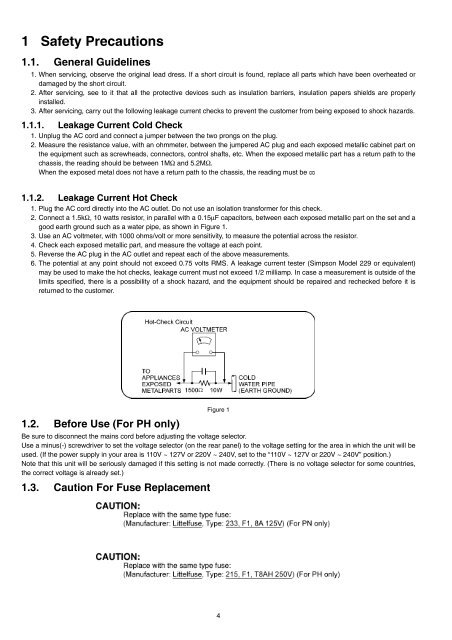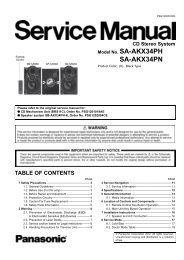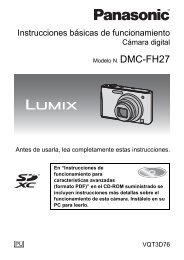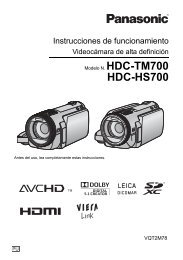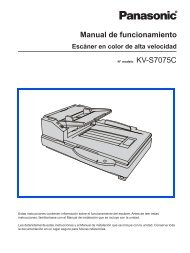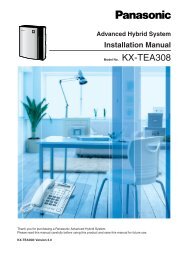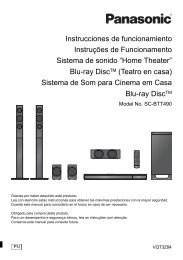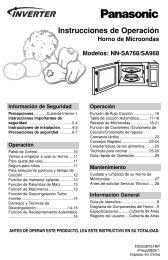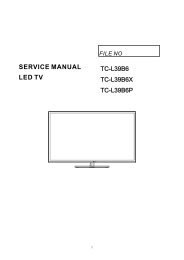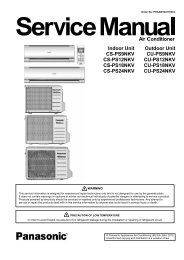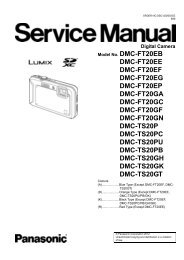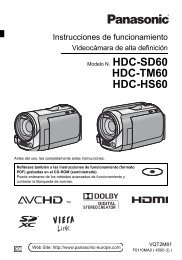SA-AK780PN - Panasonic
SA-AK780PN - Panasonic
SA-AK780PN - Panasonic
Create successful ePaper yourself
Turn your PDF publications into a flip-book with our unique Google optimized e-Paper software.
1 Safety Precautions<br />
1.1. General Guidelines<br />
1. When servicing, observe the original lead dress. If a short circuit is found, replace all parts which have been overheated or<br />
damaged by the short circuit.<br />
2. After servicing, see to it that all the protective devices such as insulation barriers, insulation papers shields are properly<br />
installed.<br />
3. After servicing, carry out the following leakage current checks to prevent the customer from being exposed to shock hazards.<br />
1.1.1. Leakage Current Cold Check<br />
1. Unplug the AC cord and connect a jumper between the two prongs on the plug.<br />
2. Measure the resistance value, with an ohmmeter, between the jumpered AC plug and each exposed metallic cabinet part on<br />
the equipment such as screwheads, connectors, control shafts, etc. When the exposed metallic part has a return path to the<br />
chassis, the reading should be between 1MΩ and 5.2MΩ.<br />
When the exposed metal does not have a return path to the chassis, the reading must be<br />
1.1.2. Leakage Current Hot Check<br />
1. Plug the AC cord directly into the AC outlet. Do not use an isolation transformer for this check.<br />
2. Connect a 1.5kΩ, 10 watts resistor, in parallel with a 0.15μF capacitors, between each exposed metallic part on the set and a<br />
good earth ground such as a water pipe, as shown in Figure 1.<br />
3. Use an AC voltmeter, with 1000 ohms/volt or more sensitivity, to measure the potential across the resistor.<br />
4. Check each exposed metallic part, and measure the voltage at each point.<br />
5. Reverse the AC plug in the AC outlet and repeat each of the above measurements.<br />
6. The potential at any point should not exceed 0.75 volts RMS. A leakage current tester (Simpson Model 229 or equivalent)<br />
may be used to make the hot checks, leakage current must not exceed 1/2 milliamp. In case a measurement is outside of the<br />
limits specified, there is a possibility of a shock hazard, and the equipment should be repaired and rechecked before it is<br />
returned to the customer.<br />
1.2. Before Use (For PH only)<br />
Figure 1<br />
Be sure to disconnect the mains cord before adjusting the voltage selector.<br />
Use a minus(-) screwdriver to set the voltage selector (on the rear panel) to the voltage setting for the area in which the unit will be<br />
used. (If the power supply in your area is 110V ~ 127V or 220V ~ 240V, set to the “110V ~ 127V or 220V ~ 240V” position.)<br />
Note that this unit will be seriously damaged if this setting is not made correctly. (There is no voltage selector for some countries,<br />
the correct voltage is already set.)<br />
1.3. Caution For Fuse Replacement<br />
4


